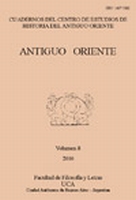Por favor, use este identificador para citar o enlazar este ítem:
https://repositorio.uca.edu.ar/handle/123456789/6751| Título: | A fragmentary cuneiform tablet from the Ophel (Jerusalem) : methodological musings about the proposed genre and Sitz im Leben Una tablilla cuneiforme fragmentaria de Ofel (Jerusalén): Reflexiones metodológicas sobre el género y el Sitz im Leben propuestos |
Autor: | Rollston, Christopher A. | Palabras clave: | ESCRITURA CUNEIFORME; ACADIOS; COMPOSICION MINERALOGICA | Fecha de publicación: | 2010 | Editorial: | Pontificia Universidad Católica Argentina. Facultad de Filosofía y Letras. Departamento de Historia. Centro de Estudios de Historia del Antiguo Oriente | Cita: | Rollston, C.A. A fragmentary cuneiform tablet from the Ophel (Jerusalem) : methodological musings about the proposed genre and Sitz im Leben [en línea]. Antiguo Oriente: Cuadernos del Centro de Estudios de Historia del Antiguo Oriente. 2010, 8 Disponible en: https://repositorio.uca.edu.ar/handle/123456789/6751 | Resumen: | Abstract: It is here argued that the genre and historical context of the cuneiform tablet from Jerusalem (“Jerusalem 1”) cannot be determined with certitude. There are simply not enough cuneiform signs preserved to facilitate such an assessment. Of course, the mineralogical analyses are useful and do demonstrate that the soil used to make the tablet was from the region of Jerusalem, but this fact cannot be construed as demonstrating that the tablet was an international letter. Rather, I believe that this fragmentary tablet could have been (among other things) some sort of literary document, some sort of letter, or some sort of legal document. Not much more than this can be said about its genre. Resumen: En este trabajo se postula que no se puede determinar con certeza el género y el contexto histórico de la tablilla cuneiforme de Jerusalén (“Jerusalén 1”). Simplemente, no se han preservado suficientes signos cuneiformes para facilitar dicha comprobación. Si bien es cierto que los análisis mineralógicos resultan útiles y demuestran que el material utilizado para realizar las tabillas proviene de la región de Jerusalén, este hecho no puede ser utilizado para demostrar que la tablilla era una carta internacional. Más bien, creo que esta tablilla fragmentaria pudo haber sido (entre otras cosas) algún tipo de documento literario, o alguna clase de carta o documento legal. No puede decirse mucho más sobre su género. |
Cobertura Espacial: | JERUSALEM | URI: | https://repositorio.uca.edu.ar/handle/123456789/6751 | ISSN: | 1667-9202 | Disciplina: | ARQUEOLOGIA | Derechos: | Acceso Abierto | Fuente: | Antiguo Oriente: Cuadernos del Centro de Estudios de Historia del Antiguo Oriente. 2010, 8 |
| Aparece en las colecciones: | AO - 2010 vol. 8 |
Ficheros en este ítem:
| Fichero | Descripción | Tamaño | Formato | |
|---|---|---|---|---|
| fragmentary-cuneiform-tablet-ophel-jerusalem.pdf | 169,21 kB | Adobe PDF |  Visualizar/Abrir |
Visualizaciones de página(s)
154
comprobado en 30-abr-2024
Descarga(s)
106
comprobado en 30-abr-2024
Google ScholarTM
Ver en Google Scholar
Este ítem está sujeto a una Licencia Creative Commons

